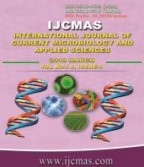


 National Academy of Agricultural Sciences (NAAS)
National Academy of Agricultural Sciences (NAAS)

|
PRINT ISSN : 2319-7692
Online ISSN : 2319-7706 Issues : 12 per year Publisher : Excellent Publishers Email : editorijcmas@gmail.com / submit@ijcmas.com Editor-in-chief: Dr.M.Prakash Index Copernicus ICV 2018: 95.39 NAAS RATING 2020: 5.38 |
Inula racemosa Hook. f. is commonly called Pushkarmool, belongs to family Asteraceae. The plant is distributed in temperate alpine Himalayas at an altitude of 1,500- 4,200m from Kashmir to Kumaon, Afghanistan to Central Nepal. Pushkarmool is commercially a very important medicinal plant of the North Western Himalayas. The plant is used in Ayurveda as an expectorant, rejuvenator and immune modulator. Root powder is reportedly hypoglycemic and hypocholesterolemic in human subjects. The species is critically endangered because of the fragile nature of its habitat, habitat destruction, illegal harvesting from the wild source, high market demand and destructive harvesting practices. The objective of the present study was to develop effective pre-sowing treatments to improve the seed germination, and to reduce mean germination time, so that protocols for commercial production of the plant could be developed and natural populations restored to ensure proper conservation of the species. In the present study phytohormones and other seed dormancy breaking chemicals were used to investigate their effect on seed germination. The results revealed highest mean percentage of germination in chilling treatment Ch1 (30 day chilled seeds) followed by treatment GA31 (Gibbrellic acid, 10-3 M) in almost all day intervals, barring 16th day interval where highest mean percentage of germination was observed in chilling treatment Ch2 (40 day chilled seeds) and least was observed in Com. 1 and control treatments. On 30th day, the highest mean percentage of germination ± SE (82±1.15) was observed in treatment Ch1 followed by GA31 (79±1.73) and least (24±1.15) was observed in treatment Com .4 (H2SO4/NAA2). However, no germination was observed treatments K1 (Potassium nitrate, 0.2 %,) and K2 (Potassium nitrate, 0.3 %). Treatment S1 (Acid scarification for 1 min.) with mean percentage of germination ± SE (31±1.15) was at par with treatment Com 2 (H2SO4/GA32), but was statistically different from all other treatments. All the treatments were statistically significant. On 28th day, the highest mean percentage of germination ± SE (82±1.15) was observed in treatment Ch1 followed by Ch2 (78±1.15) and GA31 (74±1.15) least (23±1.15) was observed in treatment Com .4. From day 14th to day 26th, treatments GA31 and GA32 (Gibbrellic acid, 10-4 M) were statistically different from each other as well as from the rest of all other treatments. From day 6th to day 18th, treatments NAA1 (Naphthalene acetic acid, 25 ppm) and NAA2 (Naphthalene acetic acid, 50 ppm) were at par with each other, but from day interval of 20th to 26th these treatments were statistically different from each other. Treatments were statistically significant on all day intervals. The germination study gives an insight into the measures to be taken to increase the efficiency of seed germination to ensure the conservation of the endangered species.
 |
 |
 |
 |
 |